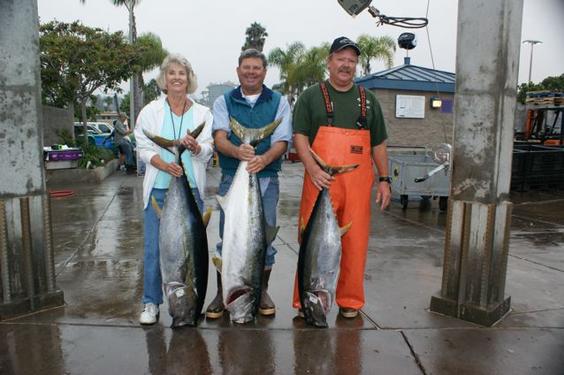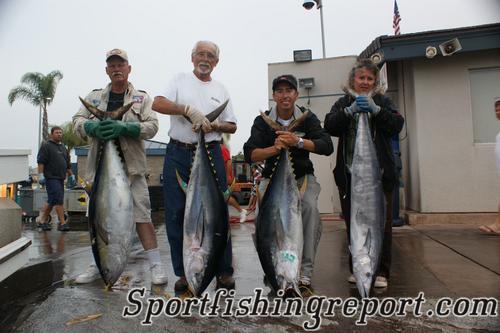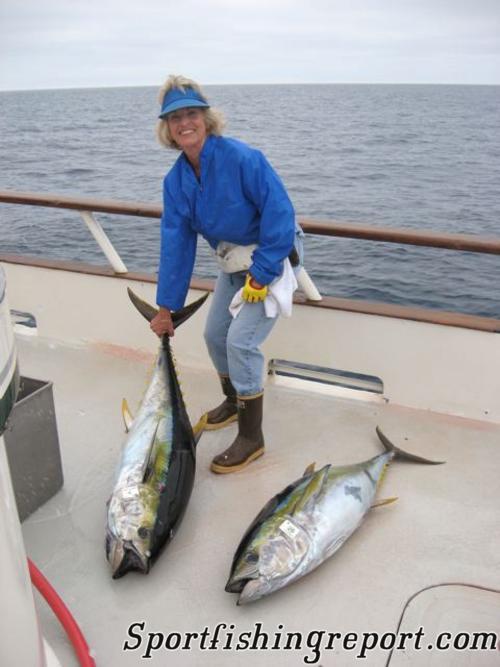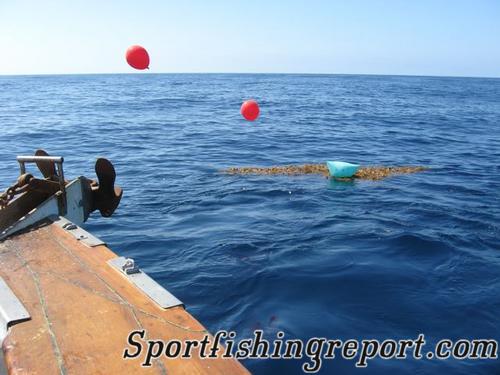Utah Fish Report
Fish Report for 9-27-2008
Fish Report for 9-27-2008
Five Days on the American Angler by Chris Dunn (September 22-27, 2008)

by Bill Roecker
9-27-2008
(619) 223-5414
Website
Multi day trips are all about options. If the fish aren't biting in one area, you have time to try out another. Or, perhaps they are biting in two different spots. In that case you can try both. I found a perfect example of this versatility on an early fall 5-day trip aboard the San Diego based long range sportfishing boat American Angler. Here is what happened:
Day 1: With 26 anglers onboard the Angler, the boat was on its way by 11 a.m. The crew loaded up the bait tanks with live sardines on our way out of San Diego Bay. We then cleared Point Loma and headed South. There would be no fishing on this day. The time was spent rigging up for the days ahead. Skipper Brian gave a brief safety talk and an overview of what we could expect for the days ahead. That was followed by a tackle and rigging seminar held by the deckhands. It's definitely a team effort on the American Angler.
Day 2: Just before first light, Skipper Brian shut down the engines, explaining that we were in the right area, but that we had to wait until it was light enough to begin trolling and looking for kelp paddies (floating clumps of seaweed that attract fish). We stopped shortly thereafter on a blind jig strike which ended up being the first yellowfin tuna of the day. I hooked a dorado that was so small I didn't even realize I had him! The fish was quickly sent back to his place in the sea and we continued the trolling in search of the next school.
A fish here, a jig strike there, nothing really that would knock your socks off about this day of fishing, until?ĶBOOM! Around 11:30 a.m. skipper Brian and his crew spotted a kelp paddy that was marked by a large inflated trash bag. Obviously another boat had been here and thought this one was worthy of pointing out to others who may be headed down this way. I can tell you this: It did not disappoint! The water was full of life. It was like watching fish in an aquarium in the clear offshore waters. First came the dorado, then micro-sized yellowtail, then the yellowfin tuna followed by a round of skipjack tuna. The action was about as fast and furious as it gets. Every bait found a fish. The only question was what kind.
As soon as I cast a sardine away from the boat, I automatically put the reel in gear and didn't have to wait long to get bit. We're talking 5 seconds or less and you had a fish on. It was that quick! The action lasted for about 2 hours, during which our group managed to put nearly 200 fish on the boat. Most of the yellowfin were of the decent school-sized variety in the 15-25 pound range. After the fish scales settled we began heading in the direction of Guadalupe Island, the next stop on this five day fishing adventure.
Day 3: We arrived at Guadalupe Island before sunrise, hoping to take advantage of what had been a steady bite on larger yellowfin tuna. These were the kind that average between 50 and 100 pounds. However, the bite really seemed to take a turn for the worse on our first day visiting the island. Only three of the bigger tuna were caught through the course of the morning, including a 66 pounder reeled in by Martha Bummer of La Crescenta, CA.
When the desired bite failed to materialize, Skipper Brian moved the boat in a little closer to the island so we could drop the anchor and perhaps entice a passing school of tuna along with some of the big homeguard yellowtail this island is famous for. We took care of both on this stop. In what could be referred to as a slow but steady pick, we caught another two dozen school-sized yellowfin tuna along with nearly 30 Guadalupe Island yellowtail. Some were on the surface, being caught on fly-lined sardines, and some were on the bottom where the dropper loop and a heavy lead weight was the ticket.
Even this bite slowed as the wind came up on the afternoon. By dinnertime, skipper Brian announced to everyone that we would stay at Guadalupe for one more day to try and get some better action out of the big fish that we knew were there. In the meantime, we would anchor up for the night on the quiet leeward side of the island and enjoy a pleasant night on the water catching small mackerel to supplement our bait supply.
Day 4: Same drill as the day before. We begin searching for schools of larger tuna. They have been hanging out under pods of black porpoise, so when you find the porpoise, the tuna aren't far behind. We did find the porpoise and the tuna, but getting them to bite was once again a tough chore. Following our successful change in plans from the day before, we anchored up and started catching quality-sized yellowtail. After a few dozen forktails came over the rail, Skipper Brian decided to see what we could find farther up the lee side of Guadalupe Island.
Stopping on a spot of fish he saw on the sonar, we found a school of yellowfin that wanted to bite! They weren't the jumbos approaching 100-pounds that had been caught in this area, but a respectable 20-30 pound average. The rest of the day was spent in search of the bigger fish to top off our success from earlier in the trip. We did find one more of the big guys. Actually, Martha Bummer found it?Ķon the end of her line! This one was in the 60-pound range.
At the end of the day we were left with a few options on how we would end this trip. Skipper Brian decided to leave the island and head for an area just Northwest of San Martin Island where the yellowfin tuna were being targeted by boats on shorter trips. This would give us another ?? day of fishing before we had to head back to the dock.
Day 5: The weather on this trip had been great up until the last day of fishing. A steady wind out of the Northwest produced waves of 5-8 feet. As we got closer to the beach the thinking was that the wind would die down and the sea would mellow. That thinking (forecast) wasn't exactly what happened. The wind continued to blow and the sea continued to bounce our 90' boat around. Despite this challenge we did manage to find more fish that wanted to bite. One kelp paddy held school-sized yellowfin tuna along with more micro yellowtail and tiny dorado.
The rest of the day was basically scratch fishing, adding to a total of 35 tuna we added to the refrigerated seawater fish hold. With the weather still up and the fish down, skipper Brian decided to call it a trip at 3 p.m., with plenty of fish for everyone and a long trip home. We will arrive around 6 a.m. the next morning following a "waffles on the bay" breakfast.
One thing I didn't mention about the trip is the food. Words could not do it justice! Chef Paul and his assistant Nate prepared some truly fantastic meals. You will not go hungry on one of these trips. The rest of the crew performed flawlessly. They obviously want to see us catching fish. But more importantly, they are all about making sure you have a good time. We did.
Day 1: With 26 anglers onboard the Angler, the boat was on its way by 11 a.m. The crew loaded up the bait tanks with live sardines on our way out of San Diego Bay. We then cleared Point Loma and headed South. There would be no fishing on this day. The time was spent rigging up for the days ahead. Skipper Brian gave a brief safety talk and an overview of what we could expect for the days ahead. That was followed by a tackle and rigging seminar held by the deckhands. It's definitely a team effort on the American Angler.
Day 2: Just before first light, Skipper Brian shut down the engines, explaining that we were in the right area, but that we had to wait until it was light enough to begin trolling and looking for kelp paddies (floating clumps of seaweed that attract fish). We stopped shortly thereafter on a blind jig strike which ended up being the first yellowfin tuna of the day. I hooked a dorado that was so small I didn't even realize I had him! The fish was quickly sent back to his place in the sea and we continued the trolling in search of the next school.
A fish here, a jig strike there, nothing really that would knock your socks off about this day of fishing, until?ĶBOOM! Around 11:30 a.m. skipper Brian and his crew spotted a kelp paddy that was marked by a large inflated trash bag. Obviously another boat had been here and thought this one was worthy of pointing out to others who may be headed down this way. I can tell you this: It did not disappoint! The water was full of life. It was like watching fish in an aquarium in the clear offshore waters. First came the dorado, then micro-sized yellowtail, then the yellowfin tuna followed by a round of skipjack tuna. The action was about as fast and furious as it gets. Every bait found a fish. The only question was what kind.
As soon as I cast a sardine away from the boat, I automatically put the reel in gear and didn't have to wait long to get bit. We're talking 5 seconds or less and you had a fish on. It was that quick! The action lasted for about 2 hours, during which our group managed to put nearly 200 fish on the boat. Most of the yellowfin were of the decent school-sized variety in the 15-25 pound range. After the fish scales settled we began heading in the direction of Guadalupe Island, the next stop on this five day fishing adventure.
Day 3: We arrived at Guadalupe Island before sunrise, hoping to take advantage of what had been a steady bite on larger yellowfin tuna. These were the kind that average between 50 and 100 pounds. However, the bite really seemed to take a turn for the worse on our first day visiting the island. Only three of the bigger tuna were caught through the course of the morning, including a 66 pounder reeled in by Martha Bummer of La Crescenta, CA.
When the desired bite failed to materialize, Skipper Brian moved the boat in a little closer to the island so we could drop the anchor and perhaps entice a passing school of tuna along with some of the big homeguard yellowtail this island is famous for. We took care of both on this stop. In what could be referred to as a slow but steady pick, we caught another two dozen school-sized yellowfin tuna along with nearly 30 Guadalupe Island yellowtail. Some were on the surface, being caught on fly-lined sardines, and some were on the bottom where the dropper loop and a heavy lead weight was the ticket.
Even this bite slowed as the wind came up on the afternoon. By dinnertime, skipper Brian announced to everyone that we would stay at Guadalupe for one more day to try and get some better action out of the big fish that we knew were there. In the meantime, we would anchor up for the night on the quiet leeward side of the island and enjoy a pleasant night on the water catching small mackerel to supplement our bait supply.
Day 4: Same drill as the day before. We begin searching for schools of larger tuna. They have been hanging out under pods of black porpoise, so when you find the porpoise, the tuna aren't far behind. We did find the porpoise and the tuna, but getting them to bite was once again a tough chore. Following our successful change in plans from the day before, we anchored up and started catching quality-sized yellowtail. After a few dozen forktails came over the rail, Skipper Brian decided to see what we could find farther up the lee side of Guadalupe Island.
Stopping on a spot of fish he saw on the sonar, we found a school of yellowfin that wanted to bite! They weren't the jumbos approaching 100-pounds that had been caught in this area, but a respectable 20-30 pound average. The rest of the day was spent in search of the bigger fish to top off our success from earlier in the trip. We did find one more of the big guys. Actually, Martha Bummer found it?Ķon the end of her line! This one was in the 60-pound range.
At the end of the day we were left with a few options on how we would end this trip. Skipper Brian decided to leave the island and head for an area just Northwest of San Martin Island where the yellowfin tuna were being targeted by boats on shorter trips. This would give us another ?? day of fishing before we had to head back to the dock.
Day 5: The weather on this trip had been great up until the last day of fishing. A steady wind out of the Northwest produced waves of 5-8 feet. As we got closer to the beach the thinking was that the wind would die down and the sea would mellow. That thinking (forecast) wasn't exactly what happened. The wind continued to blow and the sea continued to bounce our 90' boat around. Despite this challenge we did manage to find more fish that wanted to bite. One kelp paddy held school-sized yellowfin tuna along with more micro yellowtail and tiny dorado.
The rest of the day was basically scratch fishing, adding to a total of 35 tuna we added to the refrigerated seawater fish hold. With the weather still up and the fish down, skipper Brian decided to call it a trip at 3 p.m., with plenty of fish for everyone and a long trip home. We will arrive around 6 a.m. the next morning following a "waffles on the bay" breakfast.
One thing I didn't mention about the trip is the food. Words could not do it justice! Chef Paul and his assistant Nate prepared some truly fantastic meals. You will not go hungry on one of these trips. The rest of the crew performed flawlessly. They obviously want to see us catching fish. But more importantly, they are all about making sure you have a good time. We did.
Photos
More Reports
Fishing Videos Reports
for Saturday, September 27th, 2008: Independence On The High Seas
: One Super Day
: The Angler???s Catch
Slack Current, Tuna Still Biting

9-25-2008
"The beat goes on," read the Royal Polaris report for September 23. "Hello everyone, things at Alijos are looking good....... Read More

www.UtahFishReports.com © 2025. All Rights Reserved.
Website Hosting and Design provided by TECK.net
Website Hosting and Design provided by TECK.net



